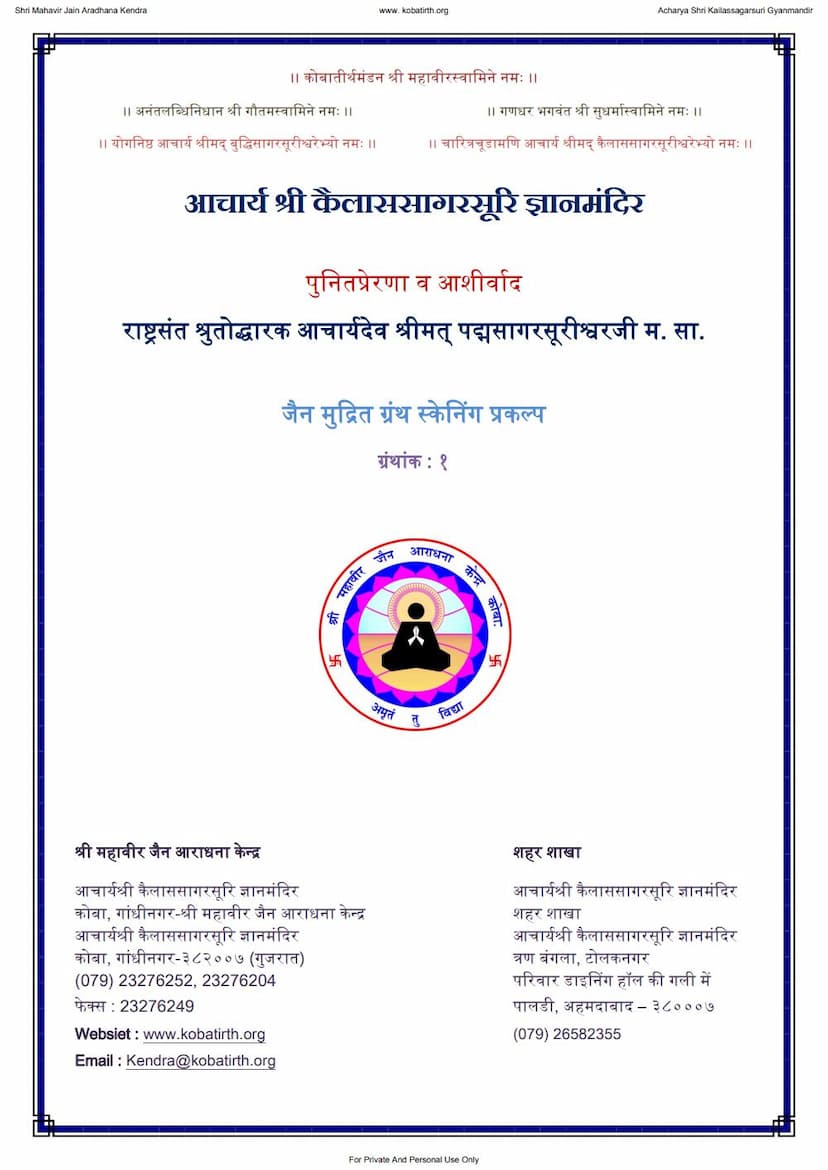Agam 05 Ang 05 Bhagvati Vyakhya Pragnapti Sutra Part 01 Shwetambar
Added to library: September 1, 2025

Summary
This comprehensive summary is based on the provided text, which appears to be the first part of the Bhagavati Sutra (also known as Vyakhya Pragnapti Sutra), an important scripture in the Shwetambar Jain tradition. The text is a profound discourse between Lord Mahavir and his chief disciple, Gautama Swami (Bhagavan Gautama), covering a vast array of philosophical, cosmological, and ethical topics.
The text begins with invocations to Lord Mahavir, Bhagavan Gautama, and Sudharma Swami, as well as the lineage of Acharya Kailassagar Suri and Padmasagar Suri, highlighting the importance of spiritual guidance and the preservation of Jain scriptures. It also acknowledges the contributions of Acharya Anand sagar Suri for revising the Agamas and Muni Purnachandrasagar for his editorial work.
The Bhagavati Sutra, as presented in this volume, delves into the following key areas:
1. The Nature of the Universe and Existence:
- Cosmology: The text discusses the structure of the universe, including different realms, heavens (Devlokas), hells (Nerayikas), and the nature of existence within them. It elaborates on the characteristics of various beings in different celestial and infernal regions, their lifespans, lifeforces, and the types of bodies and senses they possess.
- Substance (Dravya): It explains the fundamental Jain concept of dravya (substance) and its categories, including soul (jiva) and non-soul (ajiva). The discussion on pudgala (matter) is particularly detailed, describing its various forms, qualities, and how it manifests. The existence of atoms (paramanu) and their aggregation into molecules (skandha) is explained.
- Space (Asti-kaya): The five asti-kayas (categories of substances that possess existence) are described: dharmastikaya (medium of motion), adharmastikaya (medium of rest), akashastikaya (space), jivasthikaya (soul), and pudgalastikaya (matter). The text clarifies their properties and pervasiveness.
- Time (Kala): The concept of time is explored, including its cyclical nature (utsarpini and avasarpini) and how beings and substances exist and change over time.
- Karma: A significant portion of the text is dedicated to the doctrine of karma, explaining the eight types of karmas (karma prakriti), their influx (asrava), bondage (bandha), duration (sthiti), intensity (vadana), and shedding (nirjara). The intricate workings of karma are analyzed in relation to different life forms and their actions.
2. The Nature of the Soul and Liberation:
- Soul (Jiva): The soul is described as eternal, sentient, and possessing inherent qualities like consciousness (chetana) and knowledge (jnana). Its bondage to karma and the path to liberation are central themes.
- Stages of Spiritual Progress: The text implicitly touches upon the stages of spiritual development, from ignorance (mithyatva) to right faith, knowledge, and conduct (samyak darshan, samyak jnana, samyak charitra), ultimately leading to liberation (moksha).
- Right Conduct (Samvara and Nirjara): The importance of controlling the influx of karmas (samvara) and shedding existing karmas (nirjara) through austerities, penance, and ethical conduct is highlighted. The text details various types of austerities and their significance.
3. Ethical Principles and Practices:
- Vows (Anuvarata and Mahavrata): The text discusses the foundational vows of Jainism, emphasizing the importance of non-violence (ahimsa), truthfulness (satya), non-stealing (asteya), celibacy (brahmacharya), and non-possession (aparigraha), both in their householder (sravaka) and monastic (sadhhu) forms.
- Renunciation and Austerity: The text details the rigorous austerities undertaken by monks and nuns, highlighting their dedication to spiritual purification and the shedding of karmas. The concept of samvara (restraint) and nirjara (shedding of karmas) are discussed in relation to these practices.
- The Path to Liberation: The discourse emphasizes that true happiness and liberation are attained through detachment, self-discipline, right knowledge, right faith, and right conduct.
4. Philosophical Concepts and Debates:
- Metaphysics: The discussions cover complex metaphysical concepts like the nature of reality, the soul's relationship with the body, the causal processes of karma, and the eternal nature of the soul.
- Epistemology: The text touches upon the sources of knowledge (pramana) and the different types of knowledge (jnana) and perception (darshana), including direct perception (avadhi), inference (anumana), and omniscience (kevala jnana).
- Heterodox Views: The dialogue often involves addressing and refuting the views of other contemporary philosophical schools, demonstrating the logical and comprehensive nature of Jain philosophy. Lord Mahavir's explanations often clarify misconceptions about the soul, karma, and the path to liberation.
5. Specific Discussions and Examples:
- The Bhagavati Sutra's Structure: The text emphasizes the dialogue format, where Gautama Swami poses questions to Lord Mahavir, who provides detailed and nuanced answers. This Q&A format makes complex philosophical ideas accessible.
- Examples and Analogies: Lord Mahavir uses numerous examples and analogies from everyday life, nature, and the experiences of various beings to illustrate profound spiritual truths, making the teachings relatable and understandable.
- Detailed Analysis of Karma: The text provides intricate details about the karmic processes, including the types of karma that bind, their duration, and the specific actions or mental states that lead to their bondage. It also explains the process of their shedding.
Overall Significance:
The Bhagavati Sutra, as represented by this volume, is a foundational text for Shwetambar Jains. It serves as a comprehensive guide to understanding the Jain worldview, emphasizing the principles of non-violence, self-control, and the pursuit of liberation through right knowledge, faith, and conduct. The detailed explanations and the logical framework presented by Lord Mahavir showcase the depth and sophistication of Jain philosophy. The text also highlights the importance of diligent study and the role of enlightened teachers in guiding individuals towards spiritual realization.
The "Part 01" designation suggests this is an initial segment of a larger work, hinting at the vast scope and depth of the Bhagavati Sutra. The inclusion of specific chapter and verse references (though not explicitly numbered in the provided text snippets) indicates a structured and methodical presentation of knowledge. The publisher and catalog link point to a dedicated effort in preserving and disseminating these important Jain scriptures.